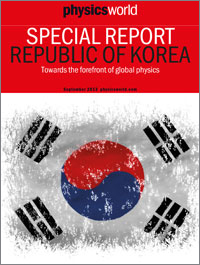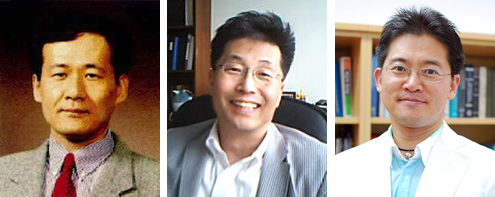By Matin Durrani

Physics World Special Report: Republic of Korea.
The Republic of Korea – known colloquially as South Korea to outsiders – has transformed itself over the last 50 years from a nation based primarily on agriculture to a hi-tech industrial powerhouse.
No longer in the shadow of its neighbouring powerhouses in Asia – China and Japan – the country is fast becoming a hotbed of top-quality research, as you can find out by reading the new Physics World Special Report on the Republic of Korea.
We delve into some of the areas of science, including synchrotron science, graphene and fusion energy, where Korea is leading the way.
The report begins with an overview of the country’s research scene, including interviews with Kookrin Char (head of physics at Seoul National University), Hawoong Jeong (head of physics at the Korean Advanced Institute of Science and Technology) and Cheol Eui Lee, a nanophysicist at Korea University in Seoul, who is also president of the Korean Physical Society.

Cheol Eui Lee, Kookrin Char and Hawoong Jeong.
Don’t miss either our profile of Park Systems – a successful hi-tech company that builds advanced atomic-force microscopes but has had to fight hard to succeed in the competitive Korean business environment, dominated as it is by giant firms such as Samsung, LG and Hyundai.
Finally, we have a fascinating interview with physicist Se-Jung Oh, president of the Institute for Basic Science (IBS) – an ambitious $5bn programme to set up some 50 research labs in the country. If the IBS succeeds, it looks as if Korea will finally shake off its follow-my-leader mentality and become one itself.
Read the Physics World Special Report: Republic of Korea now!
South Korea, in less than two generation(about 50 yeqrs), starting from an utter poverty, has become one of the most advanced and dynamic countries in the world in almost every sphere of development: microelectronics, nuclear energy with the construction and export of nulear reactors against a strong competison, work on fusion locally and as a part of the international project ITER, in space tecnology, heavy indutsry, even, in the domain of cultural export. How did all of this come about? Through a clear vision that was realised singlemindedly even through a period of tough dictatorship of President Rhee (his daughter is the present head of state!). This vision continues in all the strategic fields via well-funded reseach centers and the setting up of new ones. Finally, I did follow the the discovery-journey in the country with your band of two. Well, you have done a good job of it!
Trackback: Blog - physicsworld.com